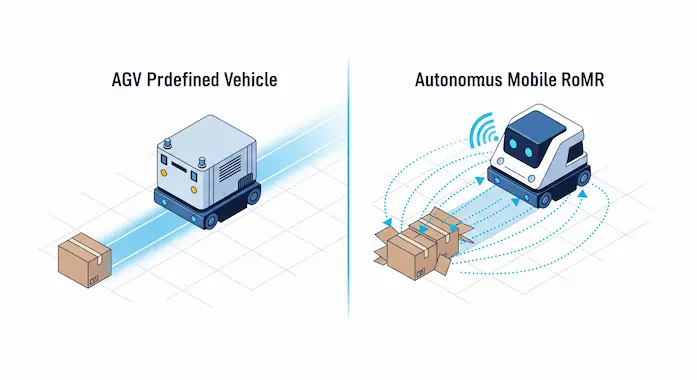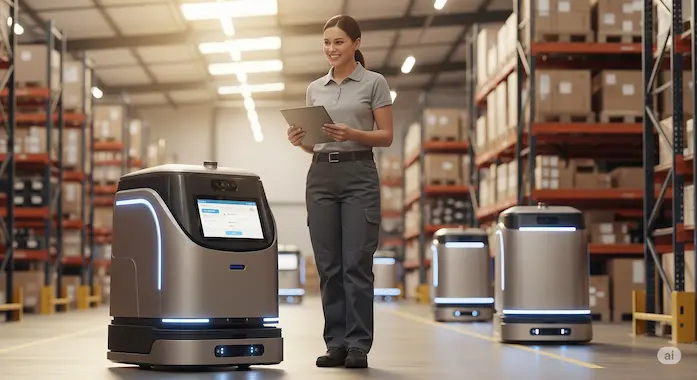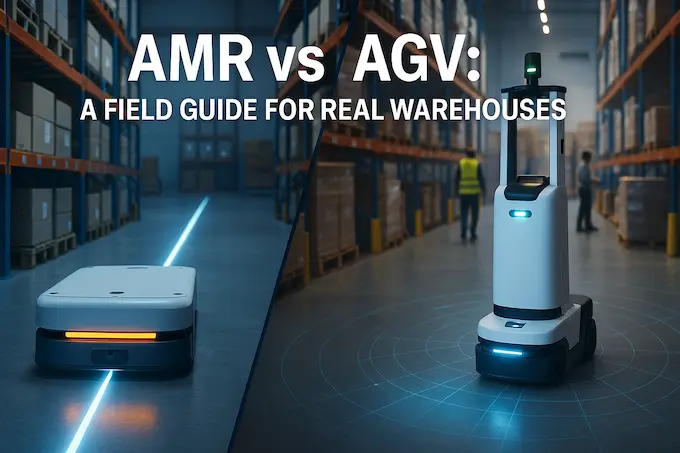Introduction
Everyone in operations eventually hits the same wall. Orders spike, aisles clog, people walk miles a day ferrying bins, and the spreadsheet says you are paying a premium to move air. The obvious answer is robots, which is why warehouse automation has moved from a wish list to a roadmap. The hard part is choosing the right ones. That is where AMR vs AGV becomes the defining question, because the shape of that choice touches everything, from floor layout and safety procedures to IT, training, and finance.
I have spent enough time around factories and distribution centers to learn a humble truth. Most productivity problems are really geometry problems. How fast can you transform the graph of your building into flow. AMRs and AGVs solve that geometry in very different ways. An automated guided vehicle traces a known line and repeats it exactly. An autonomous mobile robot reads the room, updates a map, and finds the best path that minute. Those philosophies ripple through cost, uptime, and what your team does every hour.
Before we dive deep, let us set clean definitions, then build a practical framework you can actually use. This is not a tour of vendor brochures. It is a realistic way to decide, in your building, with your constraints, which system pays back first and scales cleanly.
Table of Contents
Quick definitions for busy people
- AGV robot. A machine that follows a predefined route. Guidance can be magnets, markers, reflectors, or a virtual line computed from a taught path. It does the same thing again and again, which is why automated guided vehicles are favored in stable, repetitive flows.
- AMR robot. A self-navigating platform, part cart and part computer vision rig. It uses lidar and cameras, fuses sensor data, keeps a live map, and plans around obstacles. It excels when the floor changes from morning to evening.
- Warehouse robots. A catchall for both, plus autonomous forklifts, tuggers, and hybrids that stack, tug, or carry.
The whole debate of AMR vs AGV starts here. Do you want fixed behavior or adaptive behavior. If your process is a metronome, predictability wins. If your process is jazz, adaptability wins.
The short version of AMR vs AGV
AGVs are simple, sturdy, and legible. You can stand at an intersection, look at the tape, and know exactly where the vehicle will travel. That clarity is great in highly regulated plants. It is also a liability when a pallet slips into the lane, because the AGV waits.
AMRs are flexible, curious, and relentless about finding a way through. They recognize new obstacles and replan. That agility keeps material flowing. It also shifts the burden from physical guides to software and fleet orchestration.
If you remember nothing else about AMR vs AGV, remember this. AGVs move the line, AMRs move the plan.
Navigation, perception, and the geometry of work

Think of your building as a weighted graph. Nodes are pick faces, pack stations, docks, and charge pads. Edges are aisles with friction, like human traffic, blind corners, and narrow rack gaps. Automated guided vehicles minimize variance by locking to a subset of edges. Autonomous mobile robots minimize cycle time by exploring more of the graph and picking the best edge in the moment.
This is why AMR vs AGV shows up first in the timelog of a single tote. With an AGV, every exception goes to zero velocity until a person clears it. With an AMR, the exception becomes a micro detour. Multiply that by thousands of transports a day and you get a very different curve for throughput.
Sensors make that detour possible. A modern AMR robot typically fuses 3D lidar, stereo or depth cameras, wheel odometry, and inertials. It matches that live picture against a map and runs a planner that can weigh cost, safety margin, and congestion. An AGV robot might also carry lidar for basic stopping, but its plan is constrained by the taught route. From a controls perspective, AMR vs AGV is closed loop adaptation versus open loop repetition.
IT, maps, and the thin layer of software that runs everything
The visible robot is only half the system. The other half runs in the server room. You will need reliable Wi-Fi, a map server, a fleet manager, and clean APIs into your WMS and MES. That is true for both camps, with different emphasis.
AGV fleets are orchestrated like a train timetable. You define waypoints and schedules, then track position and blocking. Change management is a physical event. You move tape, reflectors, or guidance markers, then validate.
AMR fleets are orchestrated like a city transit app. You keep a base map, push live updates, and let the planner choose routes based on traffic and tasks. Change management is mostly digital. You remap or edit zones in software, then push a new policy.
If your IT team likes infrastructure as code, AMRs tend to fit better. If your facilities team runs the show, AGVs feel more comfortable. AMR vs AGV should include a frank conversation with whoever owns your integrations.
What work are you actually automating
Not all moves are equal. Long, predictable hauls from receiving to bulk storage are AGV territory. Highly variable runs between pack, buffers, kitting, and forward pick are AMR territory. The clever play, in many buildings, is a stack that uses both.
You can stage pallets with an autonomous forklift, feed lanes with an AGV tug, and let a swarm of AMRs do the last fifty meters into dynamic pick zones. That layered design smooths the load on every aisle. It also sidesteps false choices. AMR vs AGV is sometimes the wrong question. The right question is how to combine them so people stop walking, product keeps moving, and exceptions do not become events.
The money conversation, AMR vs AGV cost and time to value
No one buys robots for fun. You buy them because the payback is clear. Cost is more than the sticker on the unit. It includes commissioning, change orders, downtime during reconfiguration, fleet software, service, and the hidden tax of babysitting stalled units. When you model AMR vs AGV cost, include that friction.
An AGV robot often wins on headline price. It can lose on change cost the first time your flow changes. An AMR robot might look expensive on day one. It often wins on day two, when you add a lane, change a buffer, or open a seasonal mezzanine. If you are a finance leader reading this, ask your team for a sensitivity analysis on layout change and task churn.
Table 1. AMR vs AGV, capability snapshot
| Axis | AGV Robot | AMR Robot |
|---|---|---|
| Navigation | Fixed routes, taught paths | Dynamic maps, real time planning |
| Obstacle response | Stop and wait | Slow, steer, reroute |
| Setup | Physical guides or taught lines | Map the floor, define rules |
| Change effort | Move tape and markers, retest | Update maps and policies |
| Best fit | Stable, repetitive lanes | Variable work and shared aisles |
| Typical uptime loss | Obstructions and manual resets | Congestion and charge windows |
| Human interaction | Separate lanes by habit | Mixed traffic with courtesy rules |
This simple grid hides a deeper point. AMR vs AGV is a bet on where your variability lives. If your product, SKUs, and promotions churn often, bet on adaptability. If you make one thing the same way for years, bet on repetition.
A practical framework for decisions
Here is how I advise teams to decide.
- Map the work, not the building. List the top twenty material moves by frequency and average distance. Note volatility, seasonal spikes, and who gets blocked by whom.
- Score each move on repeatability. If a move is the same path and payload every time, mark it high. If it hops across zones or shares narrow aisles with pickers, mark it low.
- Quantify exception rate. Count stalls, rescues, and manual overrides. AMR vs AGV reacts to exceptions very differently, so this number swings the model.
- Estimate change cost. Include tape moves, retests, map updates, training refresh, and downtime. Use the last twelve months as a guide.
- Model AMR vs AGV cost with a three year horizon. Capture capital, software, service, batteries, and the people time to keep everything flowing.
- Pick the simplest stack that wins the math. Often that is a blended fleet.
Do this in a spreadsheet. Share it with finance early. The goal is not a perfect model, it is an honest one.
Table 2. Example TCO model for a midsized site
| Cost bucket | AGV annualized | AMR annualized |
|---|---|---|
| Units and spares | 320,000 | 410,000 |
| Fleet software | 40,000 | 60,000 |
| Commissioning and changes | 110,000 | 35,000 |
| Rescues and resets | 75,000 | 18,000 |
| Downtime impact | 90,000 | 30,000 |
| Power and batteries | 22,000 | 24,000 |
| Training and safety | 18,000 | 22,000 |
| Total | 675,000 | 599,000 |
Numbers will vary, and that is the point. Once you put your own estimates in the buckets, AMR vs AGV stops being a debate and becomes a plan.
Pilots that teach the right lessons
A good pilot is small and real. Pick one or two high value flows with different profiles. For example, run an AGV tug on a fixed milk run from receiving to bulk storage. In parallel, run autonomous mobile robots on replenishment into a fast pick module. Instrument everything. Measure cycle time per tote or pallet, interventions per hundred missions, and heat maps of blockage.
Run a weekly review. Invite the pick team lead, facilities, IT, and finance. Share the dashboards in plain language. Say what broke, what improved, and what surprised you. That rhythm builds trust. It also surfaces hidden work. AMR vs AGV decisions are won in those rooms, not in glossy decks.
Change management, or why robots succeed and fail
People do not fear robots. People fear bad rollouts. Communicate early, train well, and give the floor a clear way to report issues. The first week will bring surprises. Keep a response crew that can tweak maps, move tape, or adjust mission priorities within the hour. Celebrate the first thousand missions completed without a rescue. Most of all, keep the focus on the human experience. If the system makes the day feel calmer and safer, adoption will follow.
Advanced topics for teams who want an edge

- Traffic policy. AMR fleets become faster when you codify right of way rules near pinch points.
- Battery orchestration. Plan charge windows like airline gates.
- APIs and alerts. Feed mission events into your WMS, and alert floor leads when the system stalls.
These ideas fold back into the same theme. AMR vs AGV is a design problem. The winning design respects the physics of your aisles and the psychology of your team.
Common traps and honest trade offs
It is easy to love a demo. Do not. Ask to see logs and failure cases. Ask how updates roll out without breaking maps. Ask how often a human touches a stalled unit. Match vendor strengths to your needs, not the other way around. Also, remember that no robot fixes a broken process. If your replenishment is chaotic, robots will move chaos faster. Fix the plan, then automate the movement.
The decision, put plainly
If your plant is stable, your routes are sacred, and product change is rare, an AGV program is a solid, rational choice. It will do the job every day with clear lanes and predictable behavior. If your site shifts layouts, adds seasonal zones, and runs mixed human traffic, an AMR program will pay back faster and grow with you.
That is the heart of AMR vs AGV. It is not about which is cooler. It is about which one fits the geometry of your work.
AMR vs AGV in real scenarios
- Greenfield distribution center. You can design around automation. AGV lanes are wide and protected. Layer AMRs for dynamic replenishment near pick faces.
- Brownfield plant with weird corridors. Old buildings come with columns and narrow chokes. AMRs thread those needle points without ripping up floors.
A word on price labels, AGV vs AMR price and how to read it
Price is an argument, cost is a model. Vendors publish unit pricing that will tempt you into quick comparisons. Resist that. Put numbers in the buckets from Table 2 and include your own exception rates. Then ask each vendor how their fleet manager reduces rescues, how map updates avoid retraining, and how charge scheduling prevents traffic jams near docks. Fold those answers into the model.
You will likely see a pattern. AGV vs AMR price at the unit level narrows as you add the total stack. AMR vs AGV cost at the system level often flips in favor of adaptability, especially when your building changes often.
The human narrative behind the charts

The best reason to automate is the most human one. Walking ten miles a day pushing a cart is not a career path. Good robots turn that grind into quiet flow. Pickers spend more time picking, forklift drivers spend less time searching for clear aisles, supervisors spend less time solving traffic jams. The day gets calmer, throughput rises, and safety improves. That is the story you want to tell the floor.
Final checklist, AMR vs AGV without the hype
- Does the work look the same every hour, or does it change with demand.
- Where do exceptions cluster, and how painful are they today.
- Who owns change, facilities or IT, and how fast can they act.
- What is your plan for charge cycles and peak hour traffic.
- How will you measure rescues and interventions.
Answer those with numbers and the decision will become obvious.
Closing thought
The first automated guided vehicles came decades ago. The first wave of autonomous mobile robots arrived when sensors got cheaper and compute got small and fast. Both families have matured. Both can be safe, reliable, and productive. The difference lives in how they handle change. Your building will change. Your demand will change. Your people will change roles as they move from pushing carts to managing flow.
That is why the question of AMR vs AGV deserves a careful, grounded answer. Not a slogan, not a demo, a clear model of your work and the geometry that drives it. Choose the system that lets the geometry relax, then get back to shipping things people want.
In the end, AMR vs AGV is a practical choice about flow, the winner is the one that keeps people safe and moves goods steadily, reliably.
Sources:
https://mobile-industrial-robots.com/blog/agv-vs-amr-whats-the-difference
https://new.abb.com/products/robotics/autonomous-mobile-robots
https://www.intel.com/content/www/us/en/learn/artificial-intelligence-robotics.html
https://arxiv.org/pdf/2406.08333
1) What is the main difference between an AMR and an AGV?
An AGV robot follows a fixed, predefined route and typically depends on physical or virtual guides. If something blocks that path, it stops and waits for help. An AMR robot builds and maintains a digital map of the facility, senses obstacles in real time, and chooses an alternate route when aisles get crowded. In short, AGVs repeat a taught pattern, while AMRs adapt to the floor as it changes.
2) How much does an AGV cost compared to an AMR?
AGVs often look cheaper on a per-unit basis, but you also pay for guides, markers, or other routing infrastructure, along with the downtime to install and later move those guides. AMRs can cost more per unit, yet they usually avoid floor modifications and come online faster. Over a three-year horizon, total cost of ownership often tips in favor of AMRs in facilities that change layouts, add seasonal zones, or frequently revise routes. In stable, long-lived lanes, AGVs can still be the better buy.
3) Is an AMR safer than an AGV in a warehouse?
Both can be very safe when engineered and operated to recognized standards such as ISO 3691-4. AGVs achieve safety through predictability and separation, since they travel known paths at controlled speeds and stop when anything intrudes. AMRs add layered perception, using sensors like lidar and depth cameras to slow down, steer around hazards, and enforce dynamic keep-out zones. The safer option is the one that matches your traffic patterns, training, and supervision. Many sites combine clear rules of the road, well-marked pedestrian spaces, and geofenced robot zones to keep risk low.
4) How long does it take to deploy an AMR system versus an AGV system?
AGV projects often require weeks to months for route design, guide installation, validation, and operator sign-off. Any future change to flow, rack positions, or lanes can add more work. AMR deployments usually move faster, because you map the building, define zones and mission rules, integrate with your WMS, and begin trials without cutting floors or laying tape. Small AMR pilots can start in days, then expand incrementally as you prove value and refine traffic policies.
5) Can you use AMRs and AGVs in the same facility?
Yes. Many high-performing sites do exactly that. A common pattern is to run AGVs on long, repetitive milk runs where predictability is king, then use AMRs for dynamic work near pick faces, buffers, and kitting cells. This pairing reduces human travel, keeps pallet highways steady, and leaves the last fifty meters to adaptive robots that can weave through changing conditions. Blended fleets also let you phase investment, prove value in one flow, and scale without a full rewire of the building.

